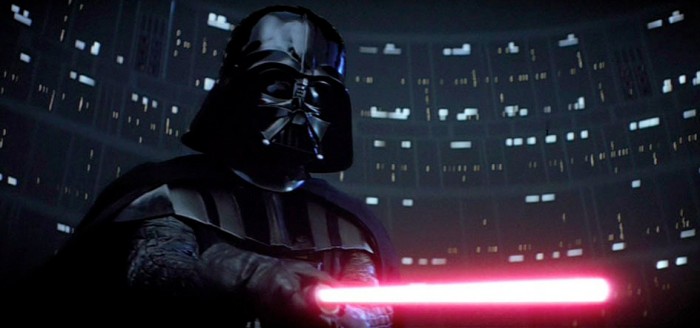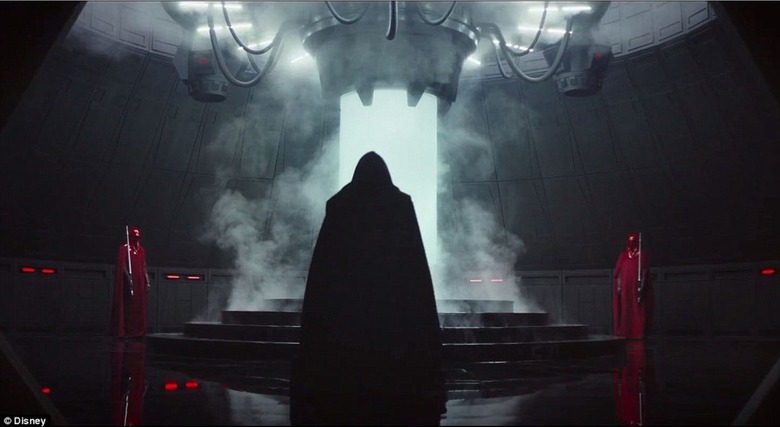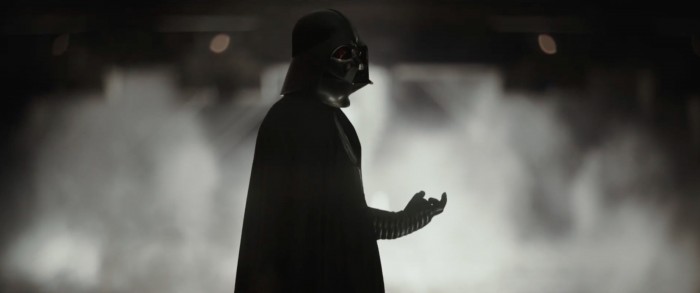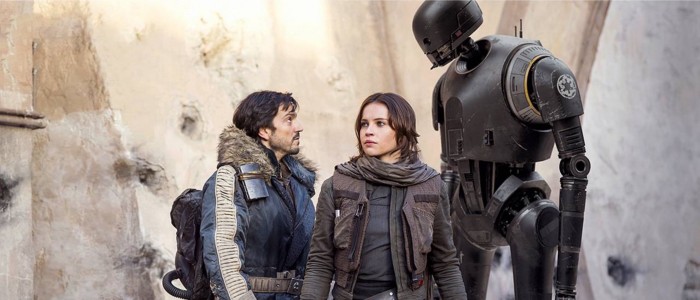Let's Talk About Darth Vader In 'Rogue One: A Star Wars Story'
Rogue One: A Star Wars Story colors outside of the regular Star Wars lines in some truly stirring ways. It's the work of people who have been thinking about this universe for decades, asking questions, imagining possibilities, and dreaming about what is happening just off camera from the the lead characters. Director Gareth Edwards films the familiar in unfamiliar ways, surrounding recognizable iconography with characters who don't adhere to the typical mold. The best parts of Rogue One are the fresh parts. The new parts.
And yet here I am, four days after seeing the film in theaters, and I can't stop thinking about those Darth Vader scenes.
(This article contains Rogue One spoilers from this point onward.)
The Anti-Redemption of Darth Vader
The Dark Lord of the Sith, the villain whose malignant presence lingers over the original trilogy, the prequel trilogy, and even the sequel taking place thirty years after his death, only has two scenes in Rogue One. The second of those scenes serves a distinct purpose, directly tying Rogue One's final moments to the opening scenes of the original 1977 Star Wars, where Darth Vader is very much present. The first of them is perhaps a bit superfluous in comparison, existing to remind the audience that this character exists (as if they had forgotten) and to give Ben Mendelsohn's haughty Director Orson Krennic his second dressing down from an original trilogy villain making a grand return.
Neither scene is especially important to the movie. Both scenes could be cut and the story of Jyn Erso, Cassian Andor, and the other rebels on board Rogue One would remain completely intact. Orson Krennic may even become a better character in this hypothetical cut, where he can exist on his own and doesn't have to live in the shadow of both Darth Vader and a digitally recreated Peter Cushing.
Yet, these are the scenes I can't stop thinking about. Not because they're great Rogue One scenes (other sequences matter to the movie in ways these two never will), but because they're great Star Wars scenes. They do something absolutely vital: they give Darth Vader his fangs back.
Darth Vader, the Mascot
Let's take a look at what has happened to Darth Vader over the past 39 years. Much like how Mickey Mouse has devolved from a plucky cartoon adventurer with a real personality to a blank-faced corporate mascot, the most famous villain in cinema history became a joke. He's the subject of children's books and "heartwarming" car commercials. He stares at you from the box art of sugary cereals. You can have your picture taken with him at Disneyland. The taming of Vader began long before Disney acquired Lucasfilm – he's been more of a punchline than a recognizable threat for decades. Culture became so comfortable with Star Wars, so comfortable for the man who used to be Anakin Skywalker, that this menace became a best friend. A good buddy. A harmless puff of hot air. The prequel films, with their baffling depiction of young Anakin as a whiny brat, certainly didn't help.
A careful watching of the original trilogy helps explain why the world learned to stop fearing and start loving this black-hearted, murderous space wizard. While Darth Vader does strike down Obi-Wan and kill a few Rebel soldiers and pilots in the original Star Wars, the bulk of his ire in the other films is focused on the officers under his command. He may be the Rebel Alliance's chief adversary, but we mostly see him picking off the Imperial stooges who fail him. It's darkly funny. It's even a little cool. The revelation of his true identity in The Empire Strikes Back and his redemption in Return of the Jedi seal the deal – Darth Vader transforms from a villain to a tragic anti-hero. Once we forgive Darth Vader, once Anakin Skywalker is redeemed, we get comfortable putting him on greeting cards.
And let's face it: Darth Vader just looks cool. That goes a lot farther than any of us want to admit.
Darth Vader, the Victim
That brings us to Darth Vader's presence in Rogue One, a film literally set in the days before the events of the original Star Wars. We're still a few years away from his lightsaber duel with Luke Skywalker and further still from his redemption on board the second Death Star. This is supposed to be the era where Darth Vader was the most feared man in the galaxy and to the film's credit, Gareth Edwards and screenwriters Chris Weitz and Tony Gilroy, deliver a version of the character we have never actually seen and have only ever imagined.
In Rogue One, we learn that Darth Vader lives in a looming, Tolkien-esque castle on Mustafar, the planet where he was mutilated and left for dead by Obi-Wan Kenobi (see, Star Wars: Episode III – Revenge of the Sith, or better yet, don't see it). We learn that he has servants at his beck and call. And, most importantly, we learn that he spends his days outside of the intimidating armor that keeps him alive, floating in a healing bacta tank. The castle itself is straight out of the original screenplay for The Empire Strikes Back (and it's the kind of grandiose homestead you'd expect from a guy like Vader), but the bacta tank is the detail to dwell on.
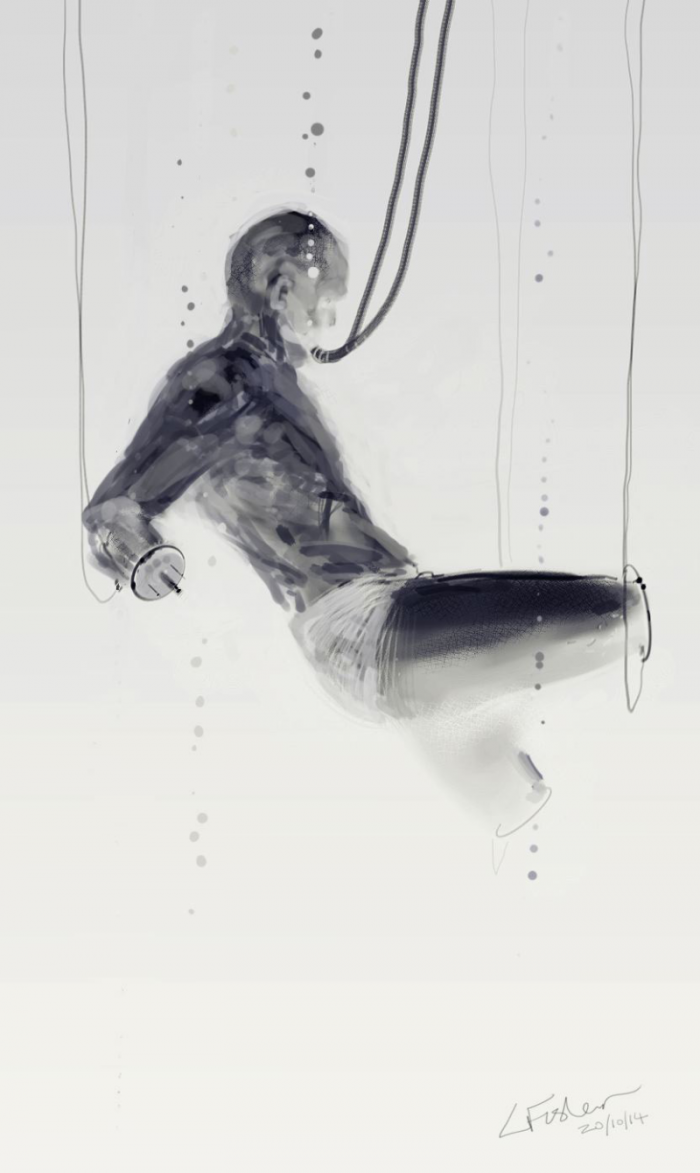
Although The Empire Strikes Back offered a brief glimpse under Darth Vader's helmet and Return of the Jedi unmasked him entirely, it can be easy to forget what exactly exists under that armor. It's one thing to know that Darth Vader is "more machine now than man," to quote Obi-Wan – it's another thing altogether to actually see him removed from his cybernetic components and robotic limbs, to see his scarred and mangled body away from that famous costume. It's a genuinely pathetic sight: a husk of a man who cannot survive without the aid of his suit, who feels compelled to live on the planet where he lost everything while spending his days trying to battle the pain of mere existence.
The implication here is that Darth Vader is in constant agony, that he's never not aware of what he lost and how he'll never be whole. The next scene, where he berates and Force-chokes Orson Krennic, has a few nice moments, but it's that establishing shot that tells us everything we need to know. The man in that black suit is never comfortable, never well, and he's surrounded himself with memories of his pain. No wonder he's so angry. No wonder he's so violent. No wonder he's so determined. For one scene, one moment, Rogue One strips away the Darth Vader parading through theme parks and pointing at you from candy wrappers and reminds you of everything this guy has lost and the bitter reality of his existence. You want to have pity on him.
Darth Vader, the Monster
But Darth Vader's second scene quickly defuses that need for pity. He shows up again in the final minutes of the film, appearing in a darkened corridor before a team of terrified Rebel soldiers on board the Alliance's flagship above Scarif. Illuminated only by the red glow of his lightsaber, he meticulously works his way toward the stolen Death Star plans, making quick work of all who stand in his way. It's Star Wars by way of Friday the 13th, with Darth Vader playing the role of Jason Voorhees. For one sequence, Rogue One becomes a bonafide horror movie and Vader becomes a bonafide monster. It's hard to imagine many young children wanting to dress as the character for Halloween after watching this scene and that may very well be the point.
It's a pretty crafty trick Rogue One pulls off in only two scenes – the film reminds you that Darth Vader is a broken mess and then it reminds you that, future redemption or not, he is a murderer in servitude to a fascist space emperor with black magic powers fueled by the evil undercurrents of the universe. The latter two films of the original trilogy ensured that Darth Vader was always far more complex than most science fiction movie villains, but Rogue One goes out of its way to ensure that our love of that complexity does not mutate into affection. The other Star Wars movies make it clear that Darth Vader is feared by the galaxy, but Rogue One has finally shown us exactly why. Darth Vader, the fearsome, angry, bitter cyborg, is scary again.*
Darth Vader and You
This redefinition of Darth Vader as a villain and not a mascot is an important step toward returning one of film history's most striking characters to his former glory, but there are other important ripple effects at play here. While Vader is portrayed as the monster he is, Rogue One builds its foundation on the ordinary men and women fighting in the rebellion. While the beloved, famous character mauls and murders, newcomers like Jyn and Cassian and Chirrut and Baze and Bodhi all give their lives for the greater good, sacrificing everything to battle authoritarianism and restore hope to a galaxy under the thumb of a tyrant. For the first time in years, the Rebel Alliance aren't just the people who die in the background while Luke and Leia get the job done – they're you and me, standing up against seemingly unstoppable villains who can cut through a corridor of armed soldiers without breaking a sweat.
While people aren't going to stop dressing in Stormtroopers or Darth Vader anytime soon, Rogue One makes a compelling case for more people to dress up like Rebel soldiers. Rogue One offers no excuses for its villains, even the famous one that three-year-olds can name. For the first time in Star Wars history, the good guys are inherently cooler than the bad guys.
And considering the state of the world right now, that may be the most important aspect of the entire damn film.
*To be fair, Marvel's exceptional Darth Vader comic series, which was written by Kieron Gillen, drawn by Salvador Larroca, and recently concluded with issue #25, also did a fine job of dwelling on the character's villainy.
And if you haven't yet, check out our previous Rogue One coverage:

